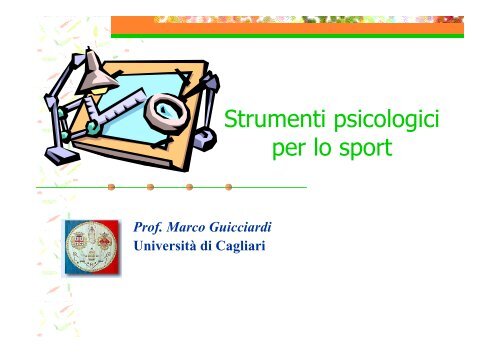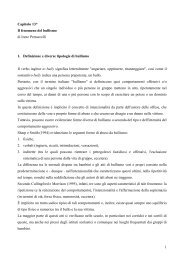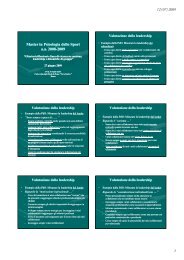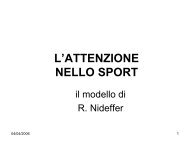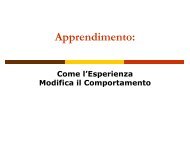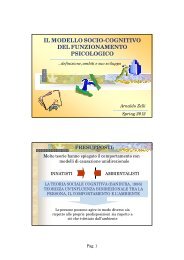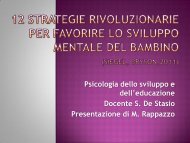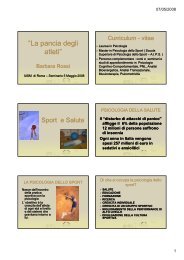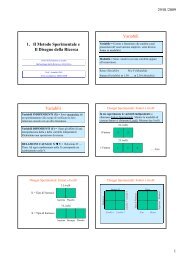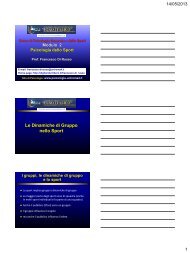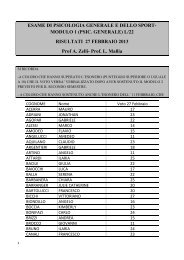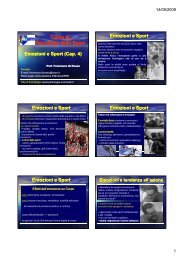1 Guicciardi_Metodologia della ricerca.pdf - Psicologia-uniroma4.it
1 Guicciardi_Metodologia della ricerca.pdf - Psicologia-uniroma4.it
1 Guicciardi_Metodologia della ricerca.pdf - Psicologia-uniroma4.it
Create successful ePaper yourself
Turn your PDF publications into a flip-book with our unique Google optimized e-Paper software.
Prof. Marco <strong>Guicciardi</strong><br />
Università di Cagliari<br />
Strumenti psicologici<br />
per lo sport
L’evoluzione delle<br />
conoscenze in un<br />
particolare<br />
ambito<br />
disciplinare è<br />
strettamente<br />
associata a:<br />
la qualità delle<br />
misure sviluppate<br />
il numero delle<br />
persone coinvolte
PSICOLOGIA DELLO SPORT E<br />
DELL’ESERCIZIO FISICO<br />
1. Capire gli effetti dei fattori<br />
psicologici sulla prestazione<br />
fisica e motoria<br />
2. Capire gli effetti <strong>della</strong><br />
partecipazione all’attività fisica<br />
sullo sviluppo, sul benessere<br />
psicologico e sulla salute
Tipi di tecniche<br />
Di rilevazione: procedure mediante cui si<br />
producono i dati (interviste, osservazione, test)<br />
Di analisi: elaborazione dei dati al fine di acquisire<br />
elementi conoscitivi sulla realtà<br />
Entrambe comportano una semplificazione<br />
<strong>della</strong> realtà<br />
Non sono tra loro indipendenti.<br />
Determinate tecniche di analisi presuppongono che le<br />
informazioni siano state rilevate in un certo modo;<br />
determinate tecniche di rilevazione pregiudicano la<br />
possibilità di ricorrere ad alcune tecniche di analisi<br />
Corbetta et al. 2001
<strong>Psicologia</strong> dello sport e<br />
dell’esercizio fisico<br />
TECNICHE DI<br />
RILEVAZIONE<br />
Utilizzo di strumenti<br />
standard<br />
Utilizzo di norme locali<br />
Messa a punto di<br />
strumenti specifici<br />
Rivalutazione degli<br />
approcci qualitativi<br />
TECNICHE DI ANALISI<br />
DEI DATI<br />
Tecniche correlazionali<br />
Tecniche multivariate<br />
SEM<br />
Modelli logistici
Pre-requisiti<br />
Cenni di metodologia <strong>della</strong> <strong>ricerca</strong> e<br />
psicometria<br />
Metodi di <strong>ricerca</strong><br />
Scale di misura<br />
Verifica di ipotesi<br />
Validazione di modelli
Proprietà: caratteristica che è possibile<br />
attribuire ad un oggetto o unità d’analisi<br />
Stati: diversi modi in cui si manifesta<br />
una proprietà<br />
Unità: referenti su cui si vogliono avere<br />
informazioni<br />
Corbetta et al. 2001
Disegno <strong>della</strong> <strong>ricerca</strong><br />
Serve a tradurre:<br />
Proprietà operativizzazione variabili<br />
Unità campionamentocasi<br />
Stati misurazione dati (o valori)<br />
Corbetta e Co.
Le variabili<br />
sono le proprietà di un evento reale che<br />
misuriamo, controlliamo, o manipoliamo<br />
nella <strong>ricerca</strong>.<br />
differiscono in molti aspetti, soprattutto<br />
nel ruolo assegnatogli nella nostra <strong>ricerca</strong><br />
ed nel tipo di misure che può essere loro<br />
applicato (vedi modi di trattare le<br />
variabili).
MODO K:si mantiene costante la variabile per tutte le<br />
osservazioni (si usa spesso per controllare variabili<br />
indirettamente rilevanti) (costante di disegno)<br />
MODO X: si controlla la variabile direttamente o<br />
indirettamente rilevante facendole assumere un<br />
particolare valore noto in un sotto-insieme di<br />
osservazioni e un diverso valore in un sotto-insieme<br />
diverso (variabile di disegno) Il modo X si riferisce sia a<br />
variabili effettivamente manipolate che a variabili non<br />
manipolate o manipolabili<br />
MODO M: si misura la variabile e si assegnano i casi ai<br />
diversi sotto-insieni derivanti da una variabile di<br />
disegno in modo che ciascuno dei sotto-insiemi abbia<br />
la stessa media (gruppi appaiati) Matching
MODO Y: si lascia la variabile libera di assumere<br />
qualsiasi valore e si osserva/registra i valori<br />
assunti (variabili osservate). Esse possono essere<br />
sia variabili dipendenti che intervenienti o<br />
covariate.<br />
MODO R: si assegnano i soggetti alle diverse<br />
condizioni sperimentali in base a criteri che<br />
garantiscano che ogni soggetto ha la stessa<br />
probabilità di essere assegnato a ciascuna<br />
condizione. (Casualizzazione o Randomizzazione)<br />
E’ indispensabile nelle indagini sperimentali in cui<br />
si vogliono trarre inferenze valide circa le relazioni<br />
di natura causale.<br />
MODO Z: si ignora la variabile, che non viene<br />
esplicitamente considerata nel disegno di <strong>ricerca</strong>.<br />
Ciò può produrre una distorsione sistematica,<br />
qualora tale variabile ignorata sia associata a una<br />
variabile di disegno.
Metodo sperimentale<br />
Stimoli diversi<br />
(per intensità, durata, frequenza)<br />
Randomizzazione Misure ripetute<br />
Matching effetto ordine<br />
e sequenza<br />
Blocking<br />
gruppi<br />
confrontabili<br />
risposte<br />
differenti<br />
Soggetti<br />
equivalentii<br />
stesso<br />
gruppo<br />
risposte<br />
differenti
Metodo differenziale<br />
Controllo<br />
variabili<br />
potenzialmente<br />
confondenti<br />
Stesso stimolo<br />
(anche item di un test)<br />
soggetti<br />
diversi<br />
per caratteristiche<br />
pre-esistenti<br />
risposte<br />
differenti
Esercitazione<br />
Identifica una tematica sportiva di tuo interesse e<br />
stabilisci uno studio atto ad esplorarla (Ricorda che<br />
uno studio si basa sulla osservazione o valutazione di<br />
variabili senza modificare l’ambiente)<br />
Quale interrogativo psicologico ti sei posto?<br />
Quali sono i fattori principali in gioco e quali relazioni<br />
intendi esaminare?<br />
Su chi baserai lo studio, chi saranno i partecipanti?<br />
Come raccoglierai i dati?<br />
Con quale tecnica statistica pensi di poterli<br />
analizzare?
Esercitazione<br />
Adesso modifica il tuo studio e crea un<br />
esperimento<br />
(Ricorda che un esperimento implica la<br />
manipolazione di fattori o variabili<br />
unitamente all’osservazione di altre,<br />
esamina come i cambiamenti in una<br />
variabile determinino i cambiamenti<br />
nell’altra).
Scale di Misurazione<br />
Le variabili differiscono riguardo a “quanto<br />
bene” esse possono essere misurate, cioè a<br />
quante informazioni la loro scala di misurazione<br />
può fornire.<br />
In ogni misurazione, c’è sempre qualche errore di<br />
misurazione che determina l’ammontare di<br />
informazioni che possiamo ottenere.<br />
Un altro fattore che determina l’ammontare di<br />
informazioni che può essere fornito da un variabile è<br />
il “tipo di scala di misurazione.”
(Trinchero 2002)
STEVENS Statistica Operazioni<br />
Scala nominale Variabili categoriali Classificazione<br />
Scala ordinale Ordinamento<br />
Scala a intervalli equivalenti Variabili cardinali Conteggio<br />
Scala a rapporti Misurazione
Una stessa variabile può essere rilevata con<br />
scale di misura diverse:<br />
Pratichi una attività sportiva ? SI NO<br />
Pratichi una attività sportiva:<br />
– per niente<br />
– da una a dieci volte al mese<br />
– più di dieci volte al mese<br />
Quante volte ti alleni in un mese? …………...
Esercitazione<br />
Identifica una variabile<br />
Stabilisci alcuni suoi indicatori<br />
Imposta su scala di misura diverse<br />
alcuni item utili per rilevarli
Vedi:<br />
Cap. 1 Corbetta<br />
Cap. 1 Keppel<br />
Per approfondimenti<br />
Cap. 1 e 2 Di Franco<br />
Cap. 1 e 2 Areni
Gli Gli psicologi psicologi non non stanno stanno proponendo proponendo alcun<br />
alcun<br />
cambiamento cambiamento cambiamento rivoluzionario rivoluzionario nel nel nel mondo<br />
mondo<br />
dell’atletica dell’atletica (…)<br />
(…)<br />
Tutto Tutto ciò ciò che che chiediamo chiediamo chiediamo è è di di essere essere perdonati<br />
perdonati<br />
per per il il nostro nostro vocabolario vocabolario tecnico tecnico e e vago vago e e che che ci<br />
ci<br />
sia sia data data l’opportunità l’opportunità di di decifrare decifrare decifrare con con calma calma e<br />
e<br />
attenzione attenzione attenzione i i principi principi che che vengono vengono utilizzati utilizzati<br />
utilizzati<br />
nella nella competizione competizione che che non non è è solo solo un un fatto fatto di di<br />
di<br />
muscoli, muscoli, ma ma anche anche di di una una mente mente pronta. pronta.<br />
pronta.<br />
Griffith Griffith (1925)
In <strong>Psicologia</strong> dello sport:<br />
Tutti i costrutti sono ipotetici<br />
Sono enunciati con il linguaggio<br />
comune: ciò aumenta la loro<br />
indeterminazione<br />
Sollecitano la individuazione di<br />
indicatori pertinenti<br />
Reclamano la costruzione di<br />
strumenti specifici<br />
Necessitano di essere validati<br />
secondo procedure standard
Idealmente, la validazione è un processo aperto<br />
in cui la teoria e la pratica sono utilizzate per<br />
sviluppare una misura, la <strong>ricerca</strong> empirica è<br />
utilizzata per testare la teoria e la misura, sia<br />
la teoria che la misura sono revisionate in<br />
relazione alla <strong>ricerca</strong>, nuove ricerche<br />
vengono condotte per valutare queste<br />
rifiniture, e la teoria e la <strong>ricerca</strong> sono utilizzate<br />
per guidare la pratica.<br />
H. W. Marsh (1998)
Ciò che può essere oggetto di validazione non è tanto<br />
la realtà o verità delle risposte misurate, quanto<br />
l’utilità delle interpretazioni derivanti dalla<br />
applicazione degli strumenti (Cronbach, 1971).<br />
I punteggi di un test possono essere utilizzati per<br />
molteplici propositi: ad esempio, la misura <strong>della</strong><br />
abilità di palleggio nella pallacanestro può essere<br />
utilizzata per creare dei gruppi omogenei di allievi,<br />
per valutare la padronanza dei movimenti<br />
fondamentali o per impostare dei programmi di<br />
esercizio.
Poiché non è lo strumento in sé ad<br />
essere “valido”, quanto piuttosto le<br />
interpretazioni dei punteggi derivanti<br />
dal suo utilizzo, in relazione a obiettivi<br />
diversi (es. selezione, formazione,<br />
diagnosi) dovremmo procedere con<br />
differenti validazioni.
JINGLE-JANGLE FALLACY<br />
Spesso la validazione preliminare dei costrutti e delle<br />
misure da essi derivate consente di evitare la fallacia<br />
di ritenere che scale che utilizzano etichette diverse<br />
debbano necessariamente misurare costrutti diversi<br />
(Jangle fallacy).<br />
Allo stesso modo l’utilizzo di una identica<br />
denominazione da parte di strumenti diversi (es.<br />
scala del nevroticismo) non garantisce che le misure<br />
corrispondenti riflettano lo stesso costrutto (Jingle<br />
fallacy) (Marsh, 1994).
SCAT<br />
SPORT COMPETITION ANXIETY TEST<br />
Test Author(s):<br />
Rainer Martens, Diane Gill, Tara Scanlan, and Julie<br />
Simon
Source:<br />
Martens, R., Vealey, R. S., & Burton, D. (1990).<br />
Competitive anxiety in sport (pp. 3-115).<br />
Champaign, IL: Human Kinetics Publishers, Inc.<br />
Purpose:<br />
To assess individual differences in competitive<br />
trait anxiety, or the tendency to perceive<br />
competitive situations as threatening and/or to<br />
respond to these situations with elevated state<br />
anxiety.<br />
Description:<br />
The SCAT contains 15 items. Participants are<br />
asked to indicate how they generally feel when<br />
they compete in sports and games and respond<br />
to each item using a 3-point ordinal scale<br />
(hardly ever, sometimes, or often). Ten of the<br />
items assess individual differences in<br />
competitive trait anxiety proneness (e.g.,<br />
"Before I compete I worry about not performing<br />
well"); five spurious items are also included to<br />
reduce possible response bias. Total scores on<br />
the SCAT range from 10 (low competitive trait<br />
anxiety) to 30 (high competitive trait anxiety).<br />
The SCAT was developed as a research<br />
instrument, and its usefulness as a diagnostic<br />
instrument for clinical evaluation has not been<br />
established. Both child (ages 10 thru 14) and<br />
adult versions of SCAT exist. Furthermore, SCAT<br />
has been translated into Spanish, French,<br />
German, Russian, Japanese, and Hungarian.<br />
Construction:<br />
Psychometric development of the SCAT was guided by the<br />
theoretical conceptualization of competitive trait anxiety as a<br />
situation-specific form of anxiety proneness that mediates, in part,<br />
an individual's perceptions of and/or responses to threat within the<br />
competitive process. Several criteria guided the format of SCAT<br />
including the need for an objective rather than projective<br />
psychological test, the need to minimize response bias, the<br />
desirability of unambiguous administration procedures, a short<br />
completion time, and easy scoring procedures. SCAT was initially<br />
constructed for use with children (ages 10 to 15). An initial pool of<br />
75 items was developed by modifying items from existing general<br />
trait anxiety scales and by adding additional sport-specific items.<br />
Based on item evaluations by six judges, a total of 21 items were<br />
retained (Version 1). The first version, consisting of 21 items<br />
retained from the original item pool plus 9 spurious items, was<br />
administered to 193 male junior high school students. Item<br />
analyses, correlation analyses between item responses and total<br />
SCAT scores, and discriminant analyses led to the retention of 14<br />
items (Version 2). The second version, consisting of the 14<br />
accepted items and 7 spurious items, was administered to two<br />
additional male junior high school samples (N=175). Item analyses,<br />
triserial correlations, and discriminant analyses led to the retention<br />
of 10 items, which when combined with 5 spurious items, formed<br />
Version 3. The third version was administered to two samples: 106<br />
male and female fifth and sixth graders, and 98 male and female<br />
junior high school students. Item analyses, triserial correlations,<br />
and discriminant analyses led to the final 15-item (including 5<br />
spurious items) child form of SCAT. An adult version of SCAT was<br />
developed by simply modifying the instructions and by changing<br />
one word for one item. Item analyses, triserial correlations, and<br />
discriminant analyses, using a sample of 153 male and female<br />
university students, supported the item integrity of this adult<br />
version of SCAT.
Reliability:<br />
Test-retest reliability coefficients for the child<br />
form (SCAT-C) among four samples of boys and<br />
girls in grades 5, 6, 8, and 9 ranged from .57 to<br />
.93 (mean r=.77) across four time intervals: 1<br />
hour, 1 day, 1 week, and 1 month. ANOVA<br />
reliability coefficients, computed on the basis of<br />
the first test administrations among these four<br />
samples, were slightly higher (mean r=.81) than<br />
the test-retest reliability coefficients reported. A<br />
higher ANOVA reliability coefficient (r=.85) was<br />
obtained for the adult version of SCAT (SCAT-A)<br />
(n=153). Kuder-Richardson formula 20 (KR-20)<br />
internal consistency coefficients, computed for<br />
the four samples used to confirm the item<br />
integrity of Version 3 of SCAT-C and for two<br />
SCAT-A samples of 268 male and female<br />
undergraduate students, ranged from .95 to .97<br />
for both forms of SCAT.<br />
Validity:<br />
Content validity was evident during the initial item selection<br />
phase; six judges who were qualified researchers in sport<br />
psychology or motor learning, and who had either conducted or<br />
were knowledgeable about research on anxiety in sport,<br />
evaluated systematically the integrity of each item selected for<br />
Version 1 of SCAT-C. The convergent validity of SCAT was<br />
supported by showing that participant responses to SCAT were<br />
positively correlated to measures of sport-specific dispositions of<br />
fear of failure, ineffective attentional focus, and cognitive and<br />
somatic anxiety. Conversely, divergent validity was<br />
demonstrated by showing participant SCAT scores to be<br />
inversely related to sport-specific dispositions of need for power<br />
and self-confidence. Concurrent validity was also supported by<br />
the low, but statistically significant positive correlation<br />
coefficients with general measures of trait anxiety and external<br />
locus of control assessments, and negative correlation<br />
coefficients with internal locus of control and self-esteem<br />
measures. Generally, SCAT demonstrated stronger correlations<br />
with sport-specific measures than with general personality tests<br />
as hypothesized. The predictive validity of SCAT was supported<br />
in that participant responses to SCAT related positively to future<br />
assessments of both general and competitive state anxiety.<br />
Participants' SCAT scores correlated more highly with their<br />
competitive than with their noncompetitive A-state responses. A<br />
meta-analysis using the validity generalization model indicated<br />
that the average correlation coefficient between SCAT responses<br />
and competitive A-state was .61. Also, SCAT was a better<br />
predictor of athletes' A-state responses than were the coaches'<br />
ratings of their players. However, the predictive validity of SCAT<br />
in relation to self-confidence and motor performance is<br />
equivocal. Furthermore, SCAT responses do not appear to be<br />
predictive of pre- and postcompetition performance<br />
expectancies.
Norms:<br />
Updated normative data on SCAT-C were<br />
provided for male and female youth sport<br />
participants (n=1094), and on SCAT-A for<br />
male and female high school (n=352)<br />
and college (n=565) athletes. Also,<br />
normative data were provided on SCAT-A<br />
for baseball, basketball, football, soccer,<br />
swimming, tennis, volleyball, and<br />
wrestling participants.<br />
Availability:<br />
Permission is granted by publishers of<br />
the Source, without written approval, for<br />
anyone to reproduce (but not publish)<br />
the SCAT for research purposes. SCAT<br />
can be found in the Source. The authors<br />
would like to receive reports of research<br />
findings resulting from use of the SCAT.<br />
References:<br />
Allyson, B., & Murray. J. H. (1990). An<br />
investigation of competitive anxiety as<br />
positive affect [Abstract]. Proceedings of<br />
the 3rd Southeast Sport and Exercise<br />
Psychology Symposium. Greensboro, NC.<br />
*Bakker, F. C., & Kayser, C. S. (1994).<br />
Effect of a self-help mental training<br />
programme. International Journal of<br />
Sport Psychology. 25, 158-175.<br />
*Barnett, N. P., Smoll, F. L., & Smith, R.<br />
E. (1993). Reduction of competitive trait<br />
anxiety in youth sports: Effects of a<br />
coach training intervention [Abstract].<br />
Proceedings of the Association for the<br />
Advancement of Applied Sport<br />
Psychology annual convention (p. 8).<br />
Montreal, Canada.<br />
*Brand, H. J., Hanekom, J. D. M., &<br />
Scheepers, D. (1988). Internal<br />
consistency of the Sport Competition<br />
Anxiety Test. Perceptual and Motor Skills,<br />
67,
Valutazione multi-dominio<br />
(Vealey e Garner-Holman 1998)<br />
Consulente<br />
(formazione, competenze, stile)<br />
Cultura Organizzativa<br />
(tipo di sport, livello, obiettivi)<br />
Contesto<br />
(allenatore, squadra, famiglia)<br />
Atleta<br />
(età, personalità, obiettivi)<br />
Misurazione Intervento<br />
Valutazione
Forme e modalità di valutazione<br />
Forma<br />
Proattiva<br />
Chiarificatrice<br />
Interattiva<br />
Monitoring<br />
Impatto<br />
Tempo<br />
Prima<br />
Durante<br />
Durante<br />
Durante<br />
Dopo<br />
Owen (1998)<br />
Approcci<br />
Valutazione bisogni<br />
Rassegna ricerche<br />
Benchmarking<br />
Valutazione valutabilità<br />
Accreditamento<br />
Ricerca azione<br />
Analisi qualità<br />
Empowerment<br />
Analisi sistema<br />
Valutazione performance<br />
Compara obiet/risultati<br />
Audit<br />
Tecniche<br />
Rassegna documenti<br />
Osservazioni diretta<br />
Focus group, Delphi<br />
Analisi documenti,<br />
osservazioni e interviste<br />
Studio intensivo caso<br />
Osservazione<br />
Analisi dei dati<br />
Indicatori<br />
Approcci sperimentali<br />
Studi estensivi e qualitativi
Per approfondimenti:
Per approfondimenti:
guicciardi@unica.it<br />
Per contatti


